False Facts About Food Labels You Thought Were True
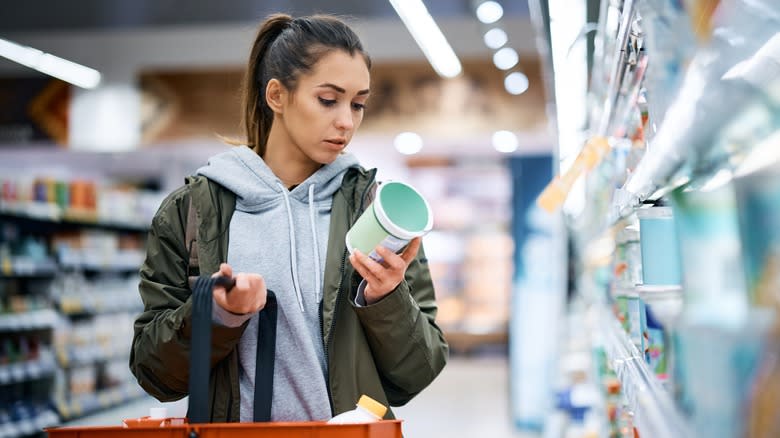
When it comes to food labels, there are plenty of misconceptions. Even what you think you know from close scrutiny of a label may not be the whole story. So it's about time you learned how to read one and understand it better.
There are lots of words on labels that probably don't mean what you think they do. One of the most misleading things about food labels is that food producers don't necessarily have to include every ingredient or nutritional fact. Food producers count on you not knowing what they have to disclose and what they don't. They also often hope that you don't know the legal definition of the words they've placed on their products to entice you to buy them.
Once you learn a bit more about what information on labels mean and what they don't, you can be a more informed shopper. Debunking a few false facts will help you make better food decisions in the future.
Read more: US Foods You Surprisingly Can't Find In Canada
False: The Word Organic On The Label Means Everything In The Product Is Organic
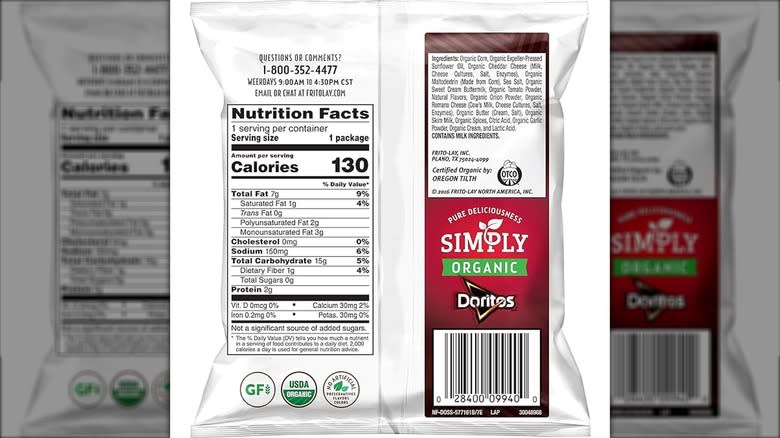
If a food label mentions that a processed product is "organic," it likely doesn't mean what you think it does. The USDA doesn't require every ingredient in an "organic" product to be organic.
There are plenty of misconceptions about organic food, and they can start with the label. Some product labels may say "made with organic" instead of "organic." That's your cue to notice which ingredient is organic. The FDA only requires that 70% of the ingredients in these products must be organic.
You may also be surprised to learn that even products labeled with a green USDA organic label don't have to be 100% organic. As expected, the product won't have any artificial colors or flavors, and it will only use natural preservatives. However, there are some items that the USDA approves for organic processed foods that don't have to be organic, such as enzymes, pectin, and baking soda. For example, if you look at the Simply Organic Doritos label, not every ingredient is listed as organic -- such as salt, enzymes, natural flavors, cheese cultures, citric acid, and lactic acid.
False: Food Labels Must Disclose All The Vitamins In A Product
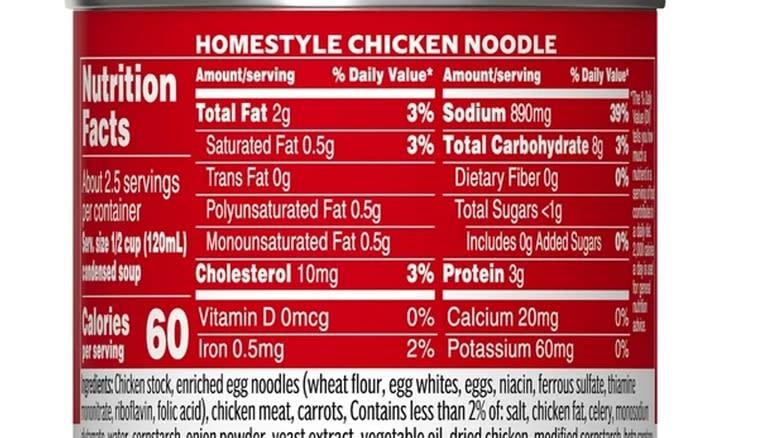
Not every vitamin and mineral in a food has to be listed on the product label. Even common ones you may assume should be listed don't have to be.
The types of vitamins required to be listed on labels in the U.S. are the ones Americans don't often get enough of in their diets. Specifically, they can lead to health problems when we don't get enough of them. Calcium and iron have been on labels for years for this reason, and now the FDA has added Vitamin D and potassium to labels for the same reason. Besides those four (calcium, iron, Vitamin D, and potassium), listing all other vitamins or minerals is voluntary unless the manufacturer adds them to the product, like in cereal, or if the label talks about them otherwise (like if it mentions that it contains Vitamin E).
Interestingly, as American diets have changed, the FDA has stopped requiring some vitamins to be listed on labels. While many companies still list Vitamins A and C on their labels, they're no longer required to be listed since most people are doing just fine getting those vitamins in their diets.
False: Serving Sizes Are Based On How Much Of The Product You Should Eat
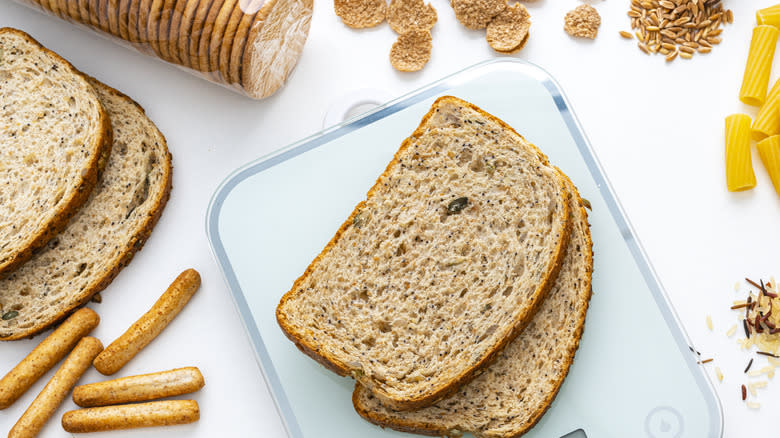
Serving sizes on packaging labels probably mean something different than you think they do. In fact, some serving sizes have changed over the years based on a change in how we eat.
You've probably been operating under the delusion that a serving size tells you how much food is healthy to eat. If so, you're completely wrong. Instead, a serving size is the amount of that food the average person actually eats at a time. As our home and restaurant portion sizes have changed, so have food label serving sizes. While the average person ate ½ cup of ice cream for dessert back in the 1990s, data from health surveys between 2003 and 2008 indicated they're more likely to be eating ⅔ of a cup of ice cream, so the serving size has increased to match our normal caloric intake.
The FDA provides guidance to food producers on reasonable servings for one sitting that they should use to create serving sizes. For example, as of December 22, 2023, the FDA says a serving of cake should be 125 grams (4.4 ounces) and a serving of milk is 240 milliliters (one cup).
False: The True Nutritional Value Of Each Product Is Listed On The Label
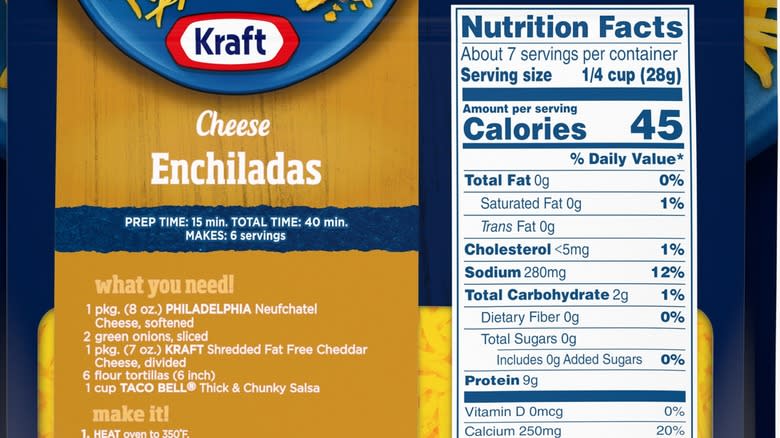
As we mentioned, not every vitamin and mineral in a product has to be listed. Other nutritional items don't have to be listed either.
To understand what the FDA requires on labels: Nutrition labels must list the serving size, calories, cholesterol, sodium, and protein. Not only should each label include the fat content, but it must show how much fat is saturated or trans fat. It has to include total carbohydrates, broken down by dietary fiber, total sugars, and how much of those sugars are added. Plus, it must tell how much Vitamin D, calcium, iron, and potassium are in the product. Any other nutritional information is voluntary.
Some stats that are no longer required include: the number of calories from fat; how much polyunsaturated fat or monosaturated fat a food has; the fiber doesn't have to be broken down into soluble or insoluble fiber; and sugar alcohols don't need to be listed.
False: The Percent Of Daily Values On A Label Should Combine To Be 100%
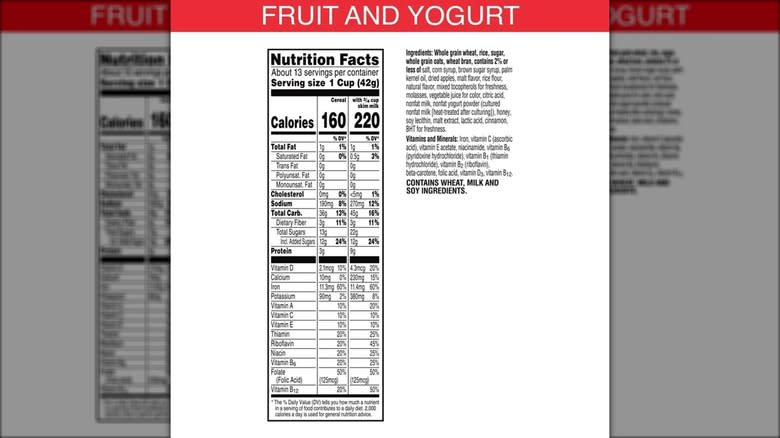
One misconception some people have about food labels relates to what "% Daily Values" mean. Some people assume that the percentages on a package should add up to 100% to tell you what percent of the product comes from each nutrient. However, this assumption is incorrect.
The percentages on packaging refer to the FDA's list of Daily Values (DV) for each nutrient. The DV tells how much of a specific nutrient you should eat or provides a limit for how much you should eat in a day to be healthy. When a food label lists the % Daily Value (% DV), it refers to what percent of the total DV for the day a food has. So, since the DV for fat is 78 grams, if a food has 39 grams of fat in it, the % DV will be 50%, indicating that one serving of the snack has half as much fat as you should consume in a day.
False: The Percent Daily Values On A Label Apply To Everyone Equally

Different people are different sizes and have different metabolisms, so each has unique nutritional needs. The % Daily Values (% DV) on food labels don't apply to everyone equally.
Keep in mind that the % DV on labels is for a 2,000-calorie daily diet, which isn't the suggested amount of calories everyone should be eating. The number of calories you need depends on your gender, how old you are, your body mass index (BMI), and how many calories you're burning each day through exercise. There are even different DV lists for those who are pregnant or lactating and for children who are three and younger.
If the amount of calories you're supposed to be eating is not 2,000 per day, you can still use a food label to determine a healthy amount for you. If you know how many calories you are supposed to be eating in a day, you can do a little math to determine the daily value for you. Simply multiply the number of calories you should eat in a day by the DV of the nutrient listed for a 2,000-calorie diet. Then divide that number by 2,000. So, if you want to figure out how much fat someone with a 1,500-calorie diet should consume, multiply 78 grams (the DV of fat for a 2,000-calorie diet) by 1,500 and divide by 2,000 to equal 58.5 grams of fat.
False: The Nutrition Listed On A Food Label Is For The Whole Package Or One Unit Inside The Package
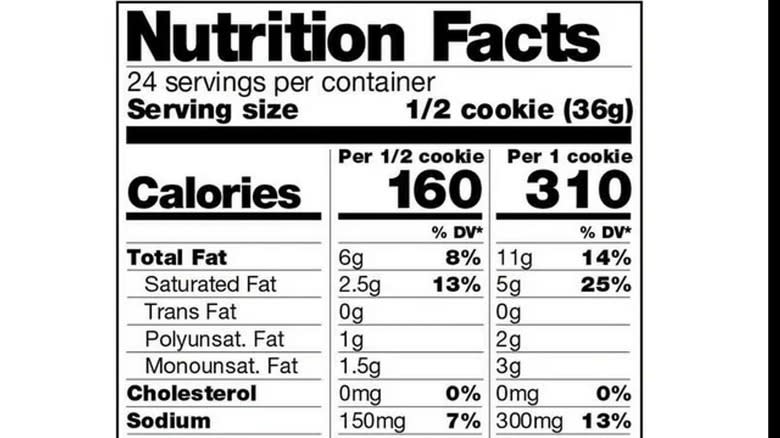
If you're concerned about nutrition, it's a good idea to notice the serving size for that particular food. We've probably all been tricked at some point into assuming that the calorie count and all the nutrients listed are for the whole package or one unit inside when that's not the case at all. One sign you should look twice? Two columns on the label.
To give you an example of how a food label might trick you, the serving size listed for a whoopie pie might be ½ of a pie, or one cookie. Some Little Debbie Oatmeal Creme Pies are smaller, and a single serving is just one cookie for 170 calories. However, you can also purchase larger ones for which a single serving is ½ of a cookie and 160 calories. If you get the larger version and eat the whole cookie, it's technically two servings, and you're consuming 310 calories.
Luckily, there's a new labeling requirement that can help you avoid being tricked by the serving size being different than you might think. The FDA now requires two columns of nutritional information for foods that "are larger than a single serving but that could be consumed in one sitting or multiple sittings." This new label also applies to foods like the Oatmeal Creme Pie cookies that have more than one serving per packaged cookie.
False: All Food Packages Require Nutrition Labels
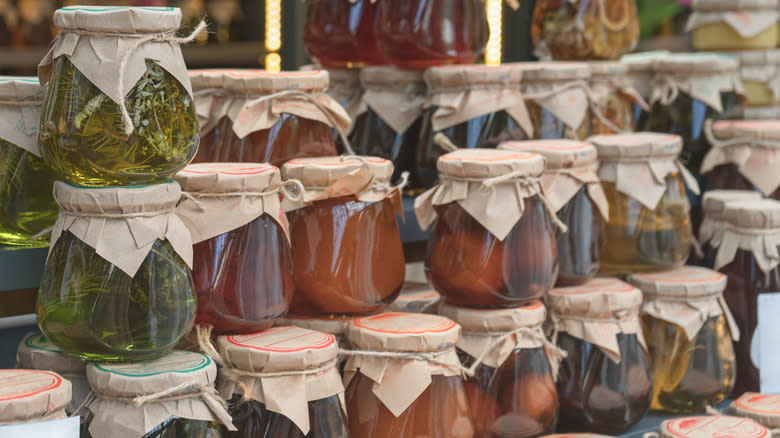
Interestingly enough, not every food package requires a nutrition label. So if you come across food that doesn't have a label, it doesn't necessarily mean that the company producing it is doing something underhanded or trying to trick you.
You're especially likely to find food products without any nutrition labels if you buy from a small producer online or in person such as at a farmer's market. In order for a company to have to put a nutrition label on its food, it needs to be a sizable company or be making a significant amount of money. A company has to put nutrition labels on its food if it makes more than $500,000 in total sales (of anything) each year and more than $50,000 of those sales are food products. A company also has to add nutrition labels if it employs more than 100 people full-time or sells more than 100,000 of any one of its products (not necessarily food products).
A small company also may be required to add a nutrition label if it makes a nutritional claim. For example, if the label says the product is low in fat, it has to include a normal nutrition label.
False: No Means No And All Ingredients Are On The Label
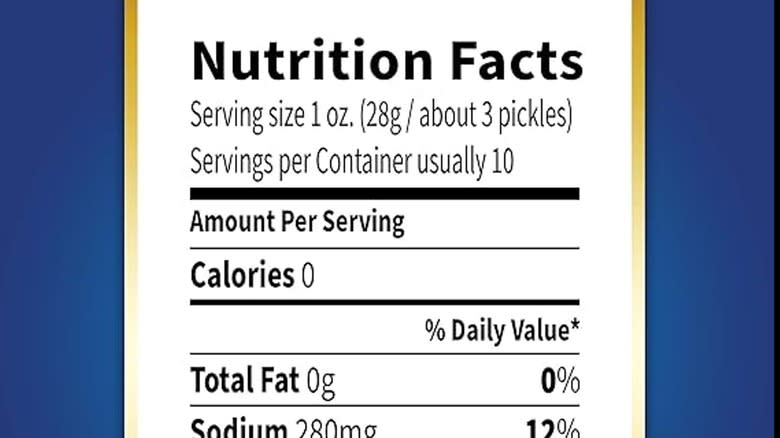
It's a good idea to approach any processed product with caution if you have special dietary needs because the label doesn't always tell the whole story. In some cases, "no" doesn't mean "no" and "0" doesn't mean none. Plus, not every ingredient and nutritional fact has to be listed. So some health claims can be a little misleading.
Calorie-free, fat-free, sodium-free, and cholesterol-free items are often not what they seem. In reality, zero-calorie items can have one to four calories. So, you can't sit around eating multiple tubs of them with no caloric effect. Items can present themselves as having zero fat as long as they have less .5 grams of fat per serving. So even a product that doesn't seem to have trans fat in it may have some (0.5 grams or less). And sodium-free products may have as many as 5 milligrams of sodium in each serving and still be listed as having 0 milligrams of sodium. Cholesterol doesn't have to be stated unless there are two or more milligrams per serving. Additionally, if a product has less than 2% DV of the vitamins and minerals normally on nutrition labels, they don't have to be listed.
Sometimes, there are also hidden ingredients that get lumped under a generic ingredient like "spices," "natural flavors," or "artificial flavors." So, it's always good to look at allergen listings in case something odd turns up (like gelatin in marshmallows).
False: More, Good Source, High, And High Potency Mean The Same Thing On A Label
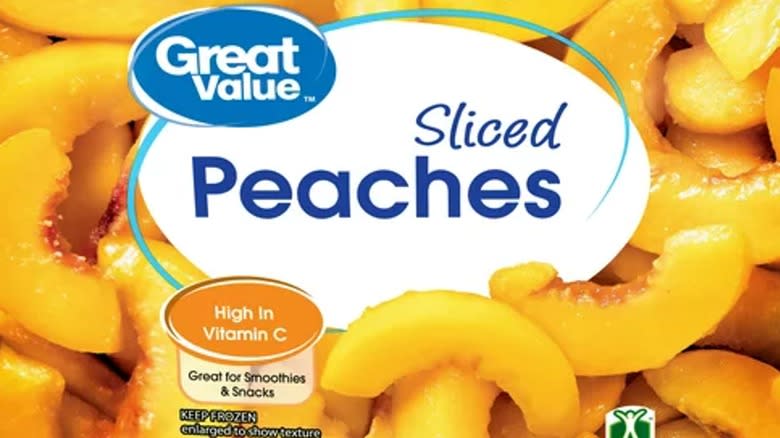
Some health claims on labels have very specific values. Since most of us don't read the whole label, paying attention to certain words can provide better ideas of how potent the nutrients in a product actually are.
The amount of a nutrients in a product is often hinted at by the wording on the label. If the item has 10% more of the Daily Value (DV) or more, you might see the words "more," "fortified," "enriched," "added," "extra," or "plus" to describe it. However, if the product has more than 10% more of the nutrient than the DV, some other words come into play. If it has 10% to 19% more of the DV, the label can say that it's a "good source" of that nutrient. If it reaches or exceeds 20% of the DV, the label can say that it's "high" or "rich in" that nutrient. So, a product labeled as having "added Vitamin C" has less Vitamin C than one that is a "good source of Vitamin C." However, a product labeled as being "high in Vitamin C" would have even more.
There's also a way to indicate that a product has 100% or more of a nutrient than the DV -- that it's "high potency." In fact, if at least ⅔ of a product has high-potency levels of nutrients, the whole product can be called "high potency," as in a "high multivitamin."
False: Artisanal Or Craft Means It's Not Factory-Made

Many of us like the idea of supporting smaller companies and, in turn, getting high-quality food that didn't come from a factory. When we see the term "artisanal" or "craft" on a food product, many of us envision hand-crafted foods made by an artisan with natural ingredients and in small batches. However, artisanal and craft products don't necessarily come from the mom-and-pop shops we envision.
You may be surprised to learn that there's no legal definition for the word "artisan" or "craft" when it comes to food. Sure, the dictionary has a definition, but that's not legally binding when it comes to food labels. So that artisan bread or craft beer may come from a factory rather than a small shop somewhere.
A little label reading and sleuthing might assist you with knowing what sort of product you're getting. It probably won't take much to realize that Sara Lee Artesano bread was factory-made, just like every other Sara Lee product at the grocery store. However, it might take a little more sleuthing to find out whether the artisan cheese you picked up at a gourmet grocery store was really made by a company larger than you originally assumed.
False: Free Range, Pasture-Raised, Or Cage-Free Means The Animals Live All Their Lives Outdoors
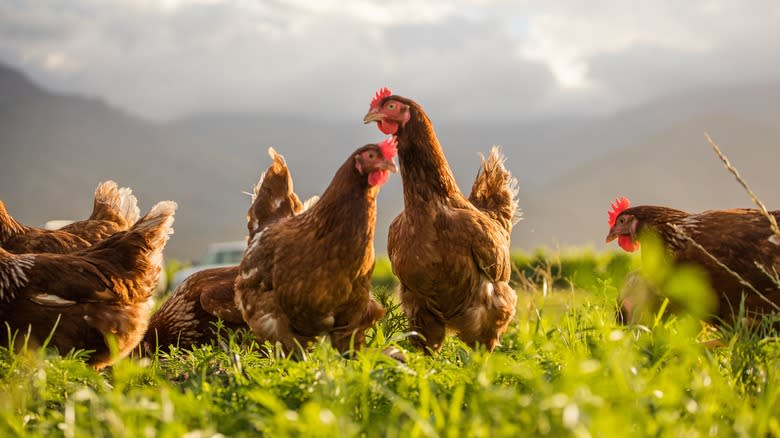
The wording regarding an animal's living conditions can be a little tricky. The differences between cage-free, free-range, and pasture-raised animals can be vast. Many times, their living conditions may not have been what you assumed.
The USDA gives specific definitions for an animal's living conditions, based on how much of its life it has access to being outside. If you see the term "cage-free" describing chickens, it might simply mean that they're able to roam in a barn or a chicken house instead of being left in a cage all their lives. So cage-free chickens likely never get to go outside like free-range ones do. However, cage-free chickens do have to have enrichment areas that allow them to act naturally to do things like perching, nesting, and scratching. A better designation for an animal is "free-range," which means it spends over 51% of its life with continuous access to being outside. Unfortunately, some farmers just leave chickens a "pop hole" that allows an animal to put its head outside without actually going outside, unless the eggs are also "certified humane."
However, there is a label that indicates that the animal hasn't been confined and has had continuous free access to being outdoors for a significant part of its life. Such animals are called "free-roaming," "pasture-raised," "pasture-grown," or "meadow-raised." However, there's no guarantee they have a decent amount of space to roam unless they're also certified humane.
False: Being Labeled As Multigrain Means It's Healthier
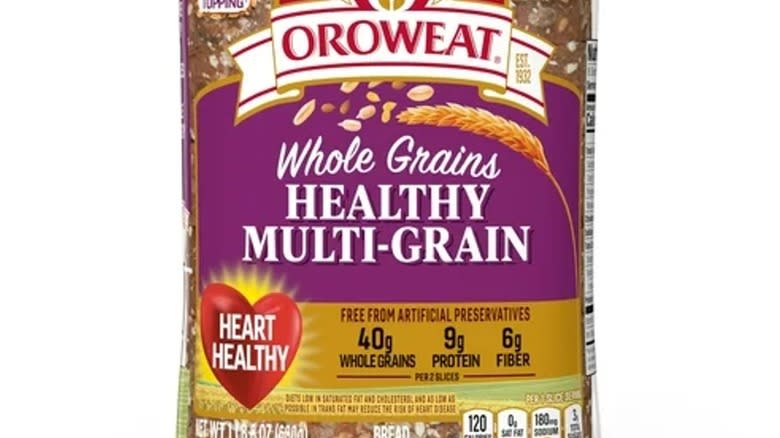
The term "multigrain" sounds like it should be healthy. However, when you think about what the parts of the word mean and its actual definition, you realize that multigrain products may not exactly be what you think they are.
Looking more closely at the meaning of "multigrain," multigrain products are simply products that combine more than one type of grain in the same product like bread or crackers. The different grains in a multigrain product do not have to be whole grains, which is where the misconception might come in.
It's easy to confuse the names of more processed grain products with those that have the potential to be healthier. Those made with whole grains keep all of the pieces of the grain rather than being ground. For example, if we're talking about bread, wheat bread is made with wheat, but whole wheat bread is made from whole grain wheat. It's similar when we talk about multigrain bread versus whole grain bread. Multigrain bread might have different types of grains in it, but if it's not also whole grain, those pieces of grain aren't intact and as healthy.
Read the original article on Mashed

